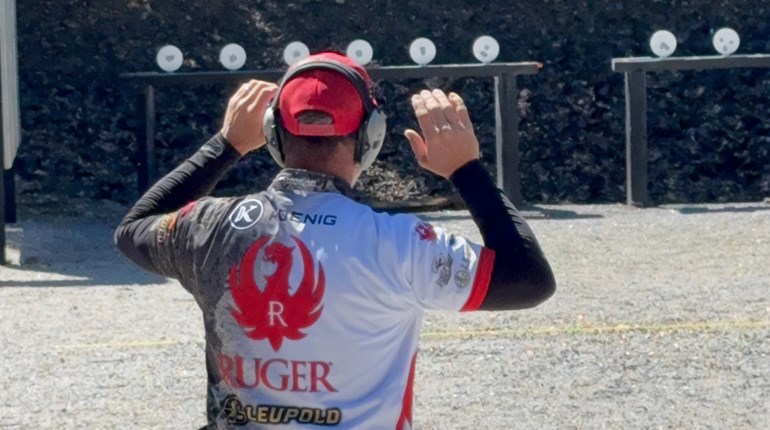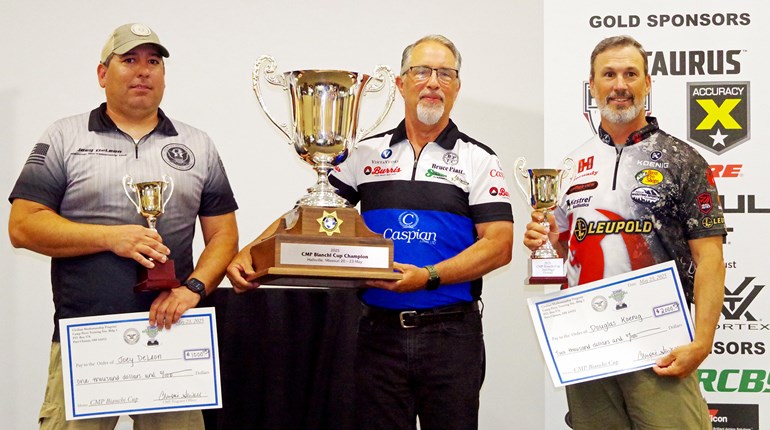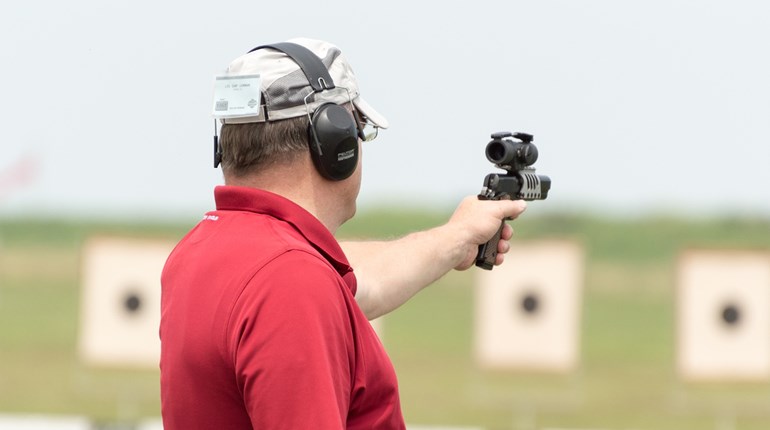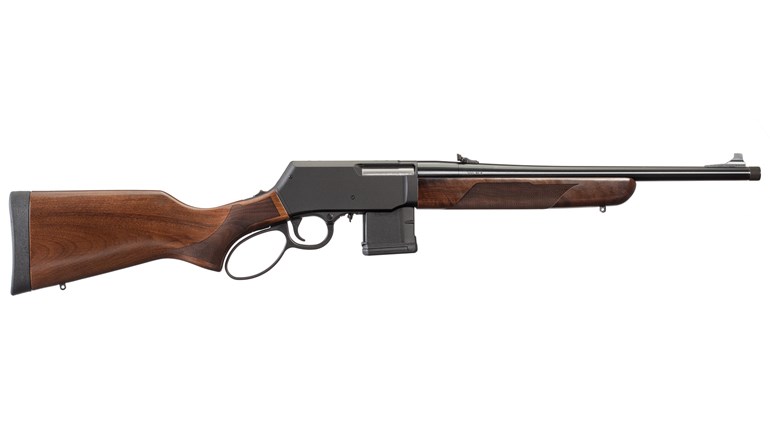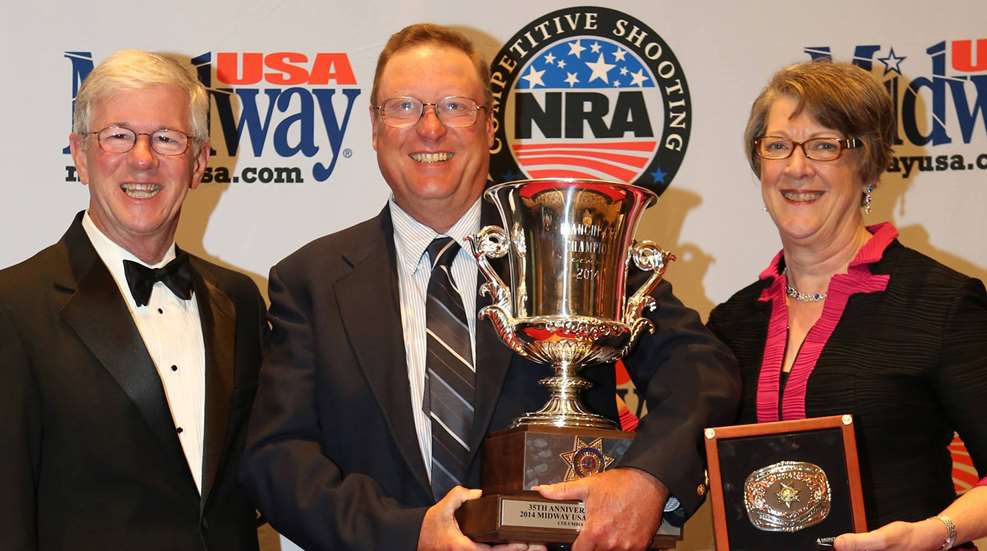
From the September 2014 issue of Shooting Sports USA.
We have some interesting groups in the shooting sports—some even humorous enough for a future article someday. From twice-a-year plinkers who seem to mostly enjoy the sound of the gun, to dedicated hobbyists, all the way to accomplished competitors. Then there are the professionals who reside at the Olympic Training Center or whose full-time job is on the range. There’s no room for error at those high levels of professional shooting, but they still seem to find time to enjoy the sport.
So it’s fun to occasionally see someone who, like most of us, balances a day job with their hobby and comes out on top. Such was the case in 2014 with Kevin Angstadt (Rural Retreat, VA) when he fired the only perfect score at the 35th NRA Bianchi Cup Championship, thus becoming the champion of perhaps the most challenging action pistol discipline of them all. Angstadt is triple distinguished in three divisions—Open, Metallic and Production.
Not one to talk about his accomplishments, we had to get background information from the NRA Pistol Department, who shared that Angstadt has won 70 NRA Action Pistol registered matches (Regional and State Championships) since 2001, more than most of his fellow competitors, and that he’s been in the top 20 at Bianchi since 2004.
You’re a Pennsylvania native, but call Rural Retreat, VA, home.
That’s right. I was born in Reading, PA. My father relocated to Wytheville, VA, in 1974. I graduated High School in Wytheville in 1982 and went into the Navy for seven years.
Were you competing in the Navy?
No. Other than shooting cans with a High Standard Double Nine .22 revolver while I was growing up, I didn’t start competing until I was 35. I left the Navy in 1989 and bought my first gun in 1990. A friend took me to a Black Powder Silhouette match and that’s where I got started in competition. I tried smallbore pistol silhouette and several other matches and eventually decided that rifle shooting didn’t fit me well, so I started focusing on pistols.
I looked-up the local listings in the 1997 American Rifleman magazine and found an Action Pistol match over in Bluefield, VA. I shot my first World match in 2006 in Australia and have made each one since, except the 2010 Championships in Sydney, Australia.
Looking back on your climb to the top, what was your focus early on?
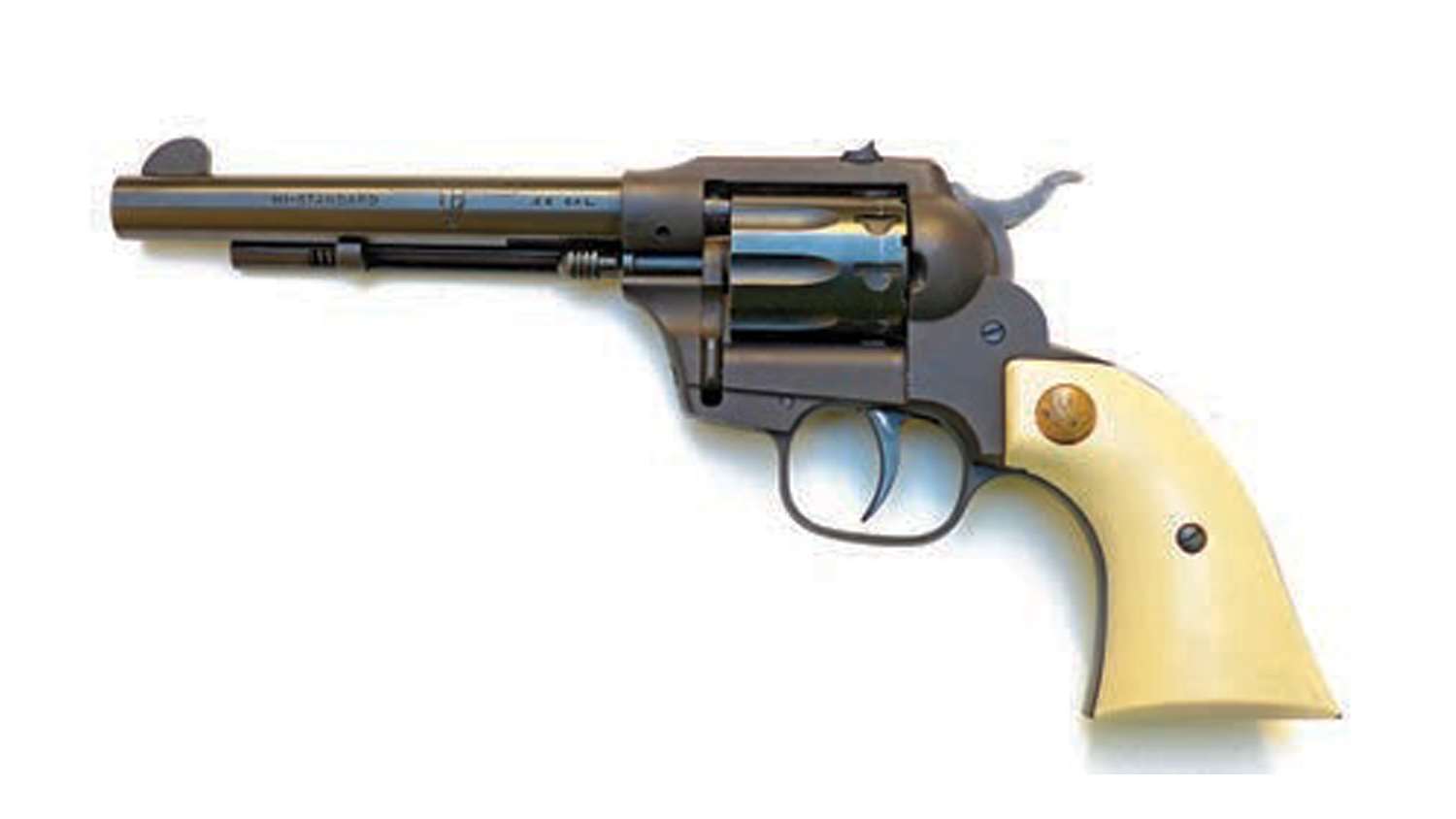
I take things in steps. Early on, the focus was running through each of the four championship events, then working on those strings that gave me the most trouble. For some reason, the Barricade event was the hardest for me to grasp. In the fall of 2004, the sport changed dramatically. We could no longer go prone anywhere except the 50-yard line. Soon after, a 2-pound trigger rule was enacted. Prior to this, we could go prone on the plates at all yard lines and each yard line on the Practical, except at 10 yards. Before the changes, the trigger on my pistol broke at just over one pound. All I had to do was think about firing the shot and touch the trigger. I wasn’t a big fan of those changes but they turned out to be the best thing that could have happened to my shooting. Suddenly, stance, grip and trigger control were very important. I could no longer shoot a High Master score (1901 or higher). It took me a good six months of constantly working on the fundamentals to get back to where I was before the rule changes. I had pretty good trigger control when I shot silhouette matches. I drew from that experience and worked on getting that same trigger press at the speed required. Soon after, my scores started rising and so did the X counts.
At my first Bianchi Cup in 2000, one of my goals was to make the top 16 for the shoot off. The main goal has always been that elusive 1920. I’ve been close twice prior to this year, each time shooting a 1918: One year, by shooting an eight on the Mover and the other, shooting an eight on the Practical. While pursuing that goal, I made my first U.S. team for the 2006 World Match held in Sydney, Australia. I have since made each World team, although I was unable to make the match in 2010. There’s a 1920 in all of us. It’s the stuff between the ears that stops us. And with Bianchi, you only get to shoot it once a year so the pressure is there once you get to the match.
I took my first lesson in 2004 from Doug Koenig. He helped me fine-tune the techniques required to compete at a high level. A shooter that averages a score of 1906 can make a subtle change in technique that can make a big difference in getting that average higher. The trick is finding that subtle change. Working with a shooter as accomplished as Doug can make a big difference in how long it takes to find that change. In my case, straightening the non-shooting arm on the barricade made that big difference. This allows the movement of the barricade to be absorbed in the shoulder and makes that movement consistent, no matter how sturdy the barricade happens to be. He also suggested changes to my pistol to make it more user-friendly for me.
How did you learn you had won?
I was sitting at the picnic table behind the Mover. My buddies were watching with binoculars. I knew I was clean but with a low X-count, so I figured I was second. We saw Doug shoot his last shot that got away from him. I got up to shake his hand as he left the range but that’s a bad time for any of us, so we didn’t talk much. Fifteen minutes later, Doug came over and congratulated me again.
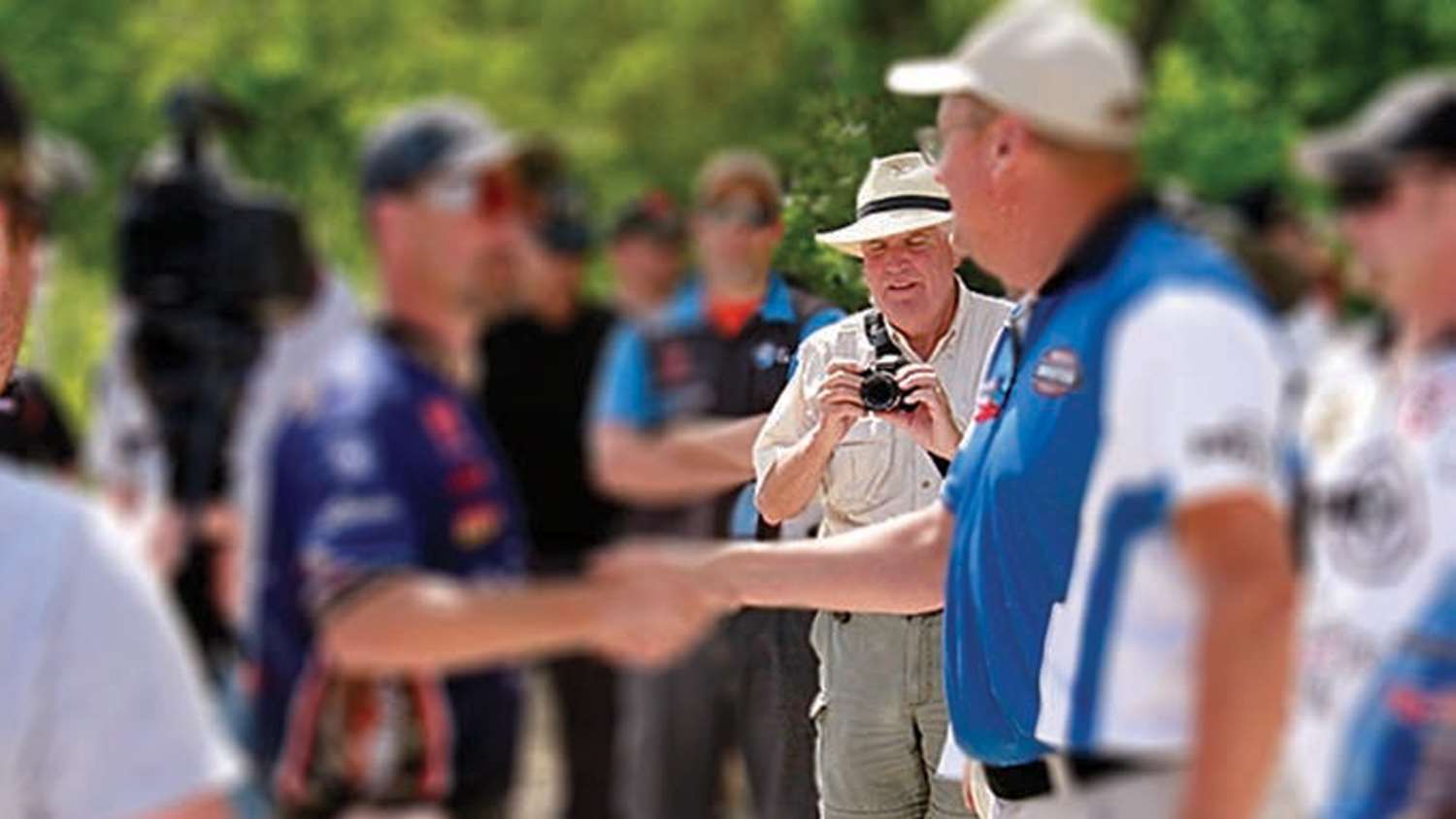
Is the ability to focus the most important trait for this sport?
I’m an Electronics Technician who maintains automated weather observation systems at general aviation airports around the country. In my job, I have to be aware of everything going on with the system and what’s not right, so you could say I’m a natural troubleshooter. I’m always aware of what’s going on in front of me. Some shooters seem to just be going through the motions. They don’t adapt to what’s happening in front of them. I’m aware of things, and if something’s not right, I immediately change it.
You have to be one with the gun–focused on what’s going on in front of you. A friend once told me that I wasn’t a very talented shooter, but I work hard at it. (Laughs)
Did you work on anything special to clean the Mover at Bianchi in 2014?
Not really … I was so dialed-in at the 15-yard line, I forgot to change my lead for the 20-yard line. I can see the holes at that distance and so I knew after the third shot what I’d done. I looked down and the lead was flipped to the wrong side.
The Mover is always everybody’s nemesis. In 2012 (Germany), I was the leader going into the last event, the Mover. I was clean until the last magazine. I shot an eight as the target went from right to left and again when the target went from left to right—pushing us all into a tie (Piatt, Koenig and me). My X-count was only good enough for second. In 2014, at the World Match in Kentucky, I was once again leading the match going into the last event, again, the Mover. I did the same thing that I did in Germany. Once again, I finished second. I finally realized that I was shooting a cadence, rather than focusing on dot placement. That discovery helped me with clean the Mover.
What’s your practice routine?
I’ll shoot here on my own property to test loads, but mostly I drive two hours to the club in Bedford. I mostly shoot matches, including the Louisiana Regional and the Michigan State Regional just before Bianchi.
After Bianchi, I shoot two matches a month along with a few days for practice. Since I travel a good bit for work, I am also able to shoot Regional and State matches held in Chambersburg, PA, Columbia, MO, Bates City, MO and San Antonio, TX. The Overlord Memorial Cup and Cardinal Cup are held each year at my home club in Bedford, VA.
Please share details about the equipment you use.
My guns are custom built by Bob Howard, who’s been with the Predator Custom Shop in Knoxville, TN since 1994. I start with a Les Baer frame and slide, a KKM barrel, Ultra Dot Match Dot, Stick Shift Mover base, Gilmore shroud and an aluminum compensator. The aluminum comp allows me to use a heavier nine-pound recoil spring to increase reliability with the light loads that we use. Reliability is extremely important. The gun must function flawlessly because there are no alibis in Action Pistol. My guns are chambered in 9x23 mm, which is similar to the .38 Super. The 9x23 mm eliminates stacking in the magazine, due to its rimless case, and it’s tapered for more reliable feeding.
My very first competition gun was a kit from Springfield Armory and I started in the Open Class, then moved to Metallic with a six-inch-long slide and a S&W 686 Plus for Production Class.
What kinds of things are you looking for in your guns?
The gun has to fit my hand comfortably. I want a good fit at the thumb and grip safety contours. I also want sharp checkering on the front strap and under the trigger guard. My prone pads are short to get the heels of my hands on the ground for a more stable platform.
Do you use Zero Bullets’ cartridges?
I use their bullets, but load my own cartridges. Winchester introduced the 9x23 mm cartridge in 1994 that I believe was originally designed by CP Bullets. One of the main advantages of the 9x23 mm case is that it is stronger than a .38 Super, with a thicker base. I use Starline brass and I can get 30 firings from a case, thanks to that thicker base. I use Winchester Super Target powder. I wanted a load that gave me around the same velocity as Winchester 231 but with a softer feel. I did what you’re not supposed to do—I developed my own load based on the burn rate chart. I studied published loads for Winchester Super Target and compared them to loads with powders that had a similar burn rate as WST for the bullet weight I wanted. The result was a load that created a push instead of the “smack” I was feeling with 231. The thing some may not know is that, due to the sharp pressure curve of WST, bullet velocity can actually drop off after a certain point of increasing the powder charge. For this reason, I no longer give out the charge weight.
I put it all together with a Dillon 1050 reloading system and spend a lot of time fine-tuning my loads. That’s what discouraged me in black powder shooting. Just crushing a couple kernels of black powder could change the point of impact until I was just shooting a pattern. I found it difficult to determine if it was my loads, or me, that was causing shooting errors.
I am using Zero Bullet’s 115-grain “conical” bullet. Their bullets have always been a round-nosed hollow point with serrations. This bullet is similar to the Hornady HAP-style bullet, but with a recessed base. The Zero conical has a little bulge near the point that seems to produce some expansion in the barrel that grabs the rifling a little better. I have shot many six-shot groups at 50 yards that can be covered with a nickel.
For up-and-coming shooters, do sponsors contact you or is it the other way around?
I went looking for them. A friend made the introduction and it took off from there. A little self-promotion makes it work. I think it has a whole lot to do with luck, and what you can bring forth for the sponsor.
Who are your sponsors?
Midsouth Shooters Supply has helped me tremendously with my reloading supplies and most of my equipment. I am shooting a Safariland ELS rig with their 014 holster. I mentioned the Predator Custom Shop and, of course, Zero Bullets.
Anything else you’d like to mention?
Most people start shooting with a centerfire gun and go from there. I say the best is a .22 with a red dot. This gives the shooter cheap ammo (normally), a cheaper gun and one with which the new shooter learns the fundamentals and timing—all without recoil. I first met Travis Hayton (High Lawman at Bianchi in 2014) when he was nine. His father, Eugene, started him off with a .22. He transitioned to a centerfire when he was fifteen.
There are 17 courses-of-fire in the NRA Action Pistol rulebook. Any USPSA or IDPA shooter could increase their performance in their chosen sport dramatically just by achieving an Expert classification in Action Pistol. These courses-of-fire test a shooter’s skills like no other. From strong hand/weak hand shooting, reloads, different shooting positions, short time limits at various distances and a variety of targets. I would like to see some of these courses-of-fire used at the Bianchi Cup, but I’m in the minority on that one.
Lastly: Because of this sport, I now have friends all over the world. Action Pistol has always been a family-like event. For the new shooters, we’ll be the first ones to help you out, even though we’re competitors. Some disciplines have big egos. Not so in Action Pistol.













